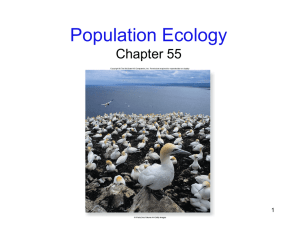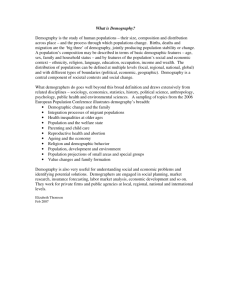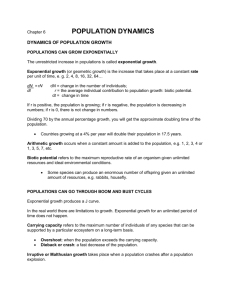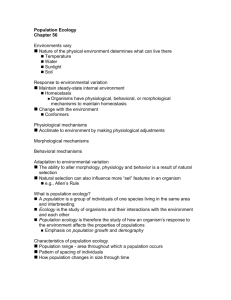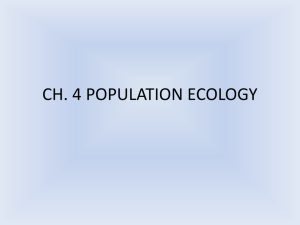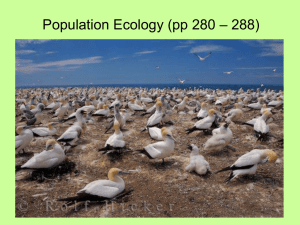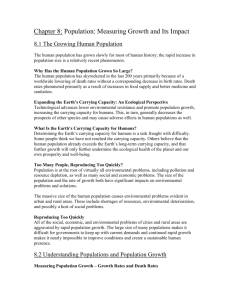Chapter 55 reading questions
advertisement
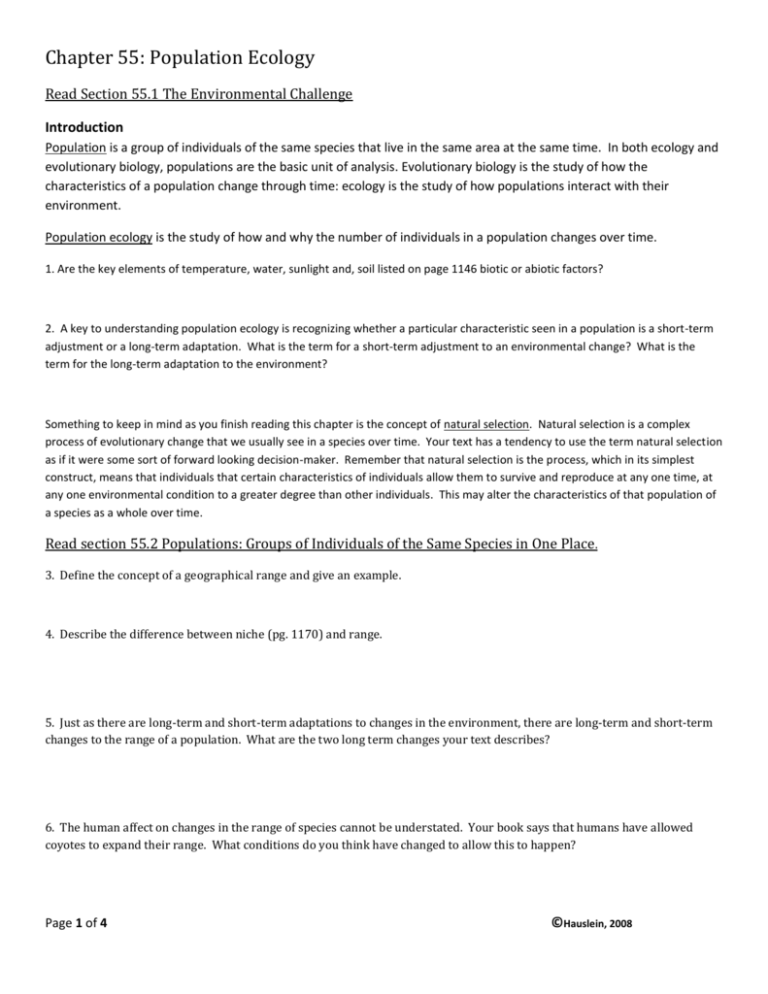
Chapter 55: Population Ecology Read Section 55.1 The Environmental Challenge Introduction Population is a group of individuals of the same species that live in the same area at the same time. In both ecology and evolutionary biology, populations are the basic unit of analysis. Evolutionary biology is the study of how the characteristics of a population change through time: ecology is the study of how populations interact with their environment. Population ecology is the study of how and why the number of individuals in a population changes over time. 1. Are the key elements of temperature, water, sunlight and, soil listed on page 1146 biotic or abiotic factors? 2. A key to understanding population ecology is recognizing whether a particular characteristic seen in a population is a short-term adjustment or a long-term adaptation. What is the term for a short-term adjustment to an environmental change? What is the term for the long-term adaptation to the environment? Something to keep in mind as you finish reading this chapter is the concept of natural selection. Natural selection is a complex process of evolutionary change that we usually see in a species over time. Your text has a tendency to use the term natural selection as if it were some sort of forward looking decision-maker. Remember that natural selection is the process, which in its simplest construct, means that individuals that certain characteristics of individuals allow them to survive and reproduce at any one time, at any one environmental condition to a greater degree than other individuals. This may alter the characteristics of that population of a species as a whole over time. Read section 55.2 Populations: Groups of Individuals of the Same Species in One Place. 3. Define the concept of a geographical range and give an example. 4. Describe the difference between niche (pg. 1170) and range. 5. Just as there are long-term and short-term adaptations to changes in the environment, there are long-term and short-term changes to the range of a population. What are the two long term changes your text describes? 6. The human affect on changes in the range of species cannot be understated. Your book says that humans have allowed coyotes to expand their range. What conditions do you think have changed to allow this to happen? Page 1 of 4 ©Hauslein, 2008 7. Your text concludes that the success of an invader species often comes at the expense of the native species (page 1149). Considering the concept of niche, why do you think these invaders have such an advantage? 8. Redwing blackbirds are known to be very territorial. In the springtime you can often drive down a country road and find a male redwing blackbird on a fence post guarding its territory. As you travel down the road you can actually count the number of fence posts between birds and that number will stay extremely consistent. Describe these observations in terms of spacing. Read Section 55.3 Population Demography and Dynamics Demography is the study of factors that determine the size and structure of populations through time. The number of individuals that are present in a population depends on four processes: birth, death, immigration, and emigration. Demography is used to make detailed predictions about the future of a population. 9. Define immigration and emigration. 10. What are three broad population characteristics that are looked at in demography? 11. In terms of demography, what term would be used for the freshmen, sophomore, junior and, senior students in your high school? A life table summarizes the probability that an individual will survive and reproduce in any given year over the course of its lifetime. Life tables were invented almost 2000 years ago; in ancient Rome they were used to predict food needs. In modern times, life tables have been the domain of life insurance companies, which have a strong financial interest in predicting the likelihood of a person dying at a given age. 12. Whooping cranes, sea turtles, spotted owls, and many other endangered species have high juvenile mortality, low adult mortality, and low fecundity. In these species, the fate of the population is extremely sensitive to increases in adult mortality. You are asked to donate money to a conservation project. Your money would either go to protecting eggs and nesting sites of sea turtles or an intensive campaign to reduce the loss of adult female sea turtles caught in fishing nets, which would you choose to donate to and why? Page 2 of 4 ©Hauslein, 2008 13. The average life expectancy of a female in the United States is about 82 years old. Looking at figure 55.11 on page 1153, at about what age does survivorship start to decline significantly? What is the reproductive probability of a woman at this age and what is the reproductive probability her female children at this time? What conclusions can you draw involving the relationship between survivorship and reproduction? Consider both the mother and the female children. Read section 55.5 Population Growth and Environmental Limits. (We’ll come back to 55.4) 14. What is the term used to describe the unlikely events described to the right? 15. If all of the acorns that squirrels forgot to dig up during the winter germinated in Spring we would be living in a sea of oak trees. Collectively, the factors that limit the innate capacity for growth are called________? 16. What is the term given to populations that are growing without limits? 17. The change of population size over time equals the maximum reproductive rate of that species times the initial population size. What is the mathematical formula for that? 18. Using the formula for exponential growth fill in the table below using an r max=0.02 Starting population 100 1000 106 (million) 108 (billion) Individuals added after 1 year 2 2nd year N 3rd year N 102 104.04 19. Though the maximum growth potential is the same what conclusions can you make about the RATE of population change as populations get larger? 20. Is the carrying capacity the same for all the species within an ecosystem? Explain your answer, using information from section 57.2 (page 1196). Read Section 55.6 Factors that Regulate Populations I wish this section were titled “How populations respond to growth” The previous section already talked about THE factor that regulates populations and that is carrying capacity. Though of course carrying capacity is really a complex and always changing interaction of both the biotic and abiotic factors in the ecosystem of any population. That said: 21. What are the biotic effects of carrying capacity called? Page 3 of 4 ©Hauslein, 2008 22. What can happen to a population as it reaches its carrying capacity? 23. What are the extreme changes in the environment called that can affect population growth/size? Now and read section 55.4 Life History and the Cost Of Reproduction Keep in mind as you read the section that the graphs do not represent cause and effect, but rather they are observational data. For example, in figure 55.13 high adult mortality per year does not cause an increase in the number of offspring per year it is an observation that in species with high adult mortality have more offspring per year. 24. So, why is it that we see the results that are demonstrated in figure 55.13? Hint: The answer is in the first sentence. 25. Would natural selection favor producing many small young or a few large ones? (Trick question!) 26. Describe the relationship between fecundity and survivorship? You could show this as a graph. 27. If ecosystems were not so complex a population in a perfect environment would reach its carrying capacity and the population would reach a steady state equilibrium. In reality, once a population reaches carrying capacity, the population size is said to be in a dynamic equilibrium, sometimes a little higher than the carrying capacity and then a bit lower. What conclusion can be made from this data presented to the right? 28. In question 30 I hope you drew a graph. Which part of the graph indicates an r-Selected adaptations and which a KSelected adaptations? Page 4 of 4 ©Hauslein, 2008



